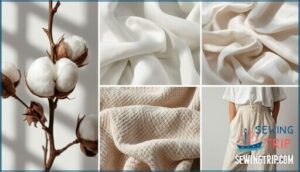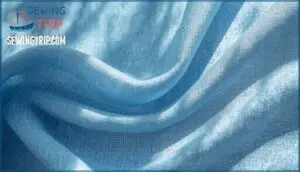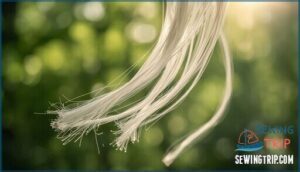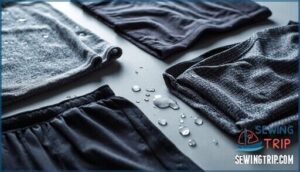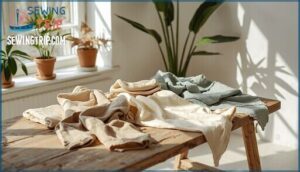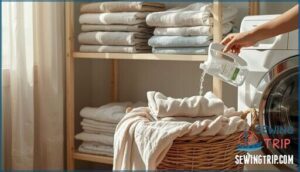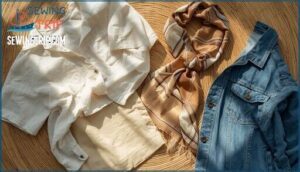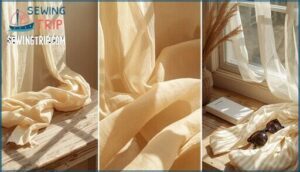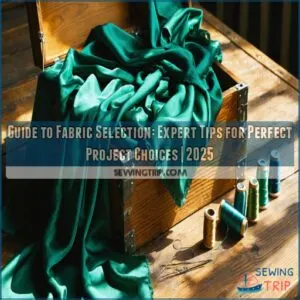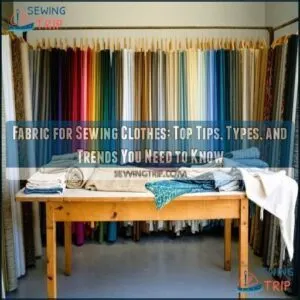This site is supported by our readers. We may earn a commission, at no cost to you, if you purchase through links.
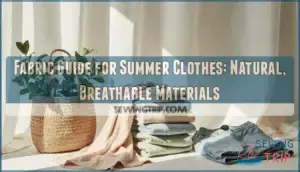
Your summer wardrobe isn’t just about style; it’s applied material science. The right fabric guide for summer clothes means understanding how fibers actually interact with heat, sweat, and airflow. Natural materials like cotton, linen, and hemp each bring distinct structural properties that determine whether you’ll feel cool or suffocated when temperatures climb.
Beyond breathability, factors like tensile strength, moisture absorption rates, and environmental impact shape which fabrics earn their place in your closet.
Table Of Contents
Key Takeaways
- Natural fibers like linen, cotton, and bamboo outperform synthetics in summer through measurable air permeability (linen reaches 300-360 cm³/s/cm²) and moisture absorption (cotton holds 25% of its weight, bamboo absorbs 40% more than cotton), creating genuine cooling through evaporation rather than heat-trapping.
- Sustainability and durability aren’t trade-offs—organic cotton cuts pesticide use and emissions by 41%, hemp requires 70% less water while lasting 20-30 years with tensile strength up to 566 MPa, and Tencel’s closed-loop process recycles 99% of solvents while biodegrading in 30-63 days.
- Proper fabric care directly extends garment lifespan: air drying prevents the 2-5% shrinkage and 10%+ color fade caused by high-heat tumble drying, while avoiding fabric softeners maintains the moisture-wicking properties that chemical buildup reduces by up to 80%.
- Strategic fabric pairing maximizes performance—mixing cotton with polyester boosts durability by 30%, layering lightweight chambray (100-150 GSM) over structured hemp balances coverage with ventilation, and matching weave density to activity level (open-weave for intense heat, tighter blends for structure) optimizes both comfort and function.
Natural Fiber Options
When summer heat turns fabric into a second skin, natural fibers offer your escape route. These materials work with your body instead of against it, pulling moisture away and letting air flow freely.
Here’s how the best natural options stack up on breathability, sustainability, and lasting comfort.
Breathability and Moisture Wicking
When you’re chasing freedom from summer’s grip, breathability and moisture wicking become your fabric’s lifeline. Natural fibers like cotton and linen offer outstanding air permeability—linen achieves rates up to 360 cm³/s/cm²—allowing thermal comfort through enhanced fabric ventilation. Cotton absorbs up to 25% of its weight in moisture, facilitating evaporative cooling.
These breathable materials create efficient moisture transport through capillary action, pulling sweat away from your skin. Unlike synthetics that trap heat, natural fibers improve wicking efficiency and moisture management, engineering a microclimate that keeps you genuinely comfortable during sweltering days.
Understanding the benefits of moisture wicking fabrics is vital for selecting the right summer clothes.
Sustainability and Eco-Friendliness
Breathability alone won’t save the planet. The fashion industry consumes 93 billion cubic meters of water annually and accounts for 10% of global carbon emissions—choose natural fibers and you’re actively resisting this damage.
Choose natural fibers—you’re actively resisting fashion’s 93 billion cubic meters of annual water waste and 10% of global carbon emissions
Organic cotton cuts pesticide use dramatically, while hemp and linen need minimal irrigation. Bamboo regrows fast, and Tencel’s closed-loop process recycles 99% of solvents. Recycled polyester diverts waste from landfills, supporting a circular economy.
These eco-friendly materials and green textiles reduce environmental impact without sacrificing breathability or moisture management. Sustainable fashion isn’t compromise—it’s liberation. Understanding the water consumption statistics is essential for making informed choices.
Durability and Comfort
Sustainability matters, but your clothes also need to survive real life. Natural fibers deliver outstanding fabric longevity and wear resistance—hemp fibers reach tensile strengths up to 566 MPa, outlasting most cottons by years.
Consider two durability factors:
- Weaving density – Linen’s tightly packed structure extends wear life by 25% compared to lightweight cotton, maintaining breathability without sacrifice.
- Fiber elasticity – Merino wool recovers from stretching without permanent damage, while hemp-based weaves resist pilling for up to 20 years.
Thermal comfort and moisture management work together here. Cotton absorbs 25% of its weight in water, providing evaporative cooling but slower drying. Linen’s hollow fibers dry 50% faster, reducing skin sensitivity and stickiness. You’re not choosing between comfort and durability—natural fibers give you both.
Cotton Fabric Guide
Cotton might just be your best ally when the heat kicks in. This natural fiber has earned its place in summer wardrobes for good reasons that go beyond simple tradition.
Let’s look at what makes cotton worth reaching for when you’re building your warm-weather collection.
Cotton is Comfortable
Cotton’s softness isn’t just pleasant—it’s measurable. In tactile tests, cotton ranks highest on comfort scales, with friction values that feel gentle against skin. You’ll notice this difference when perspiration starts: cotton maintains surface dryness 25% longer than synthetics, absorbing moisture without that clammy sensation.
Its natural cellulose structure creates breathability that adjusts to your body temperature. Whether you choose lightweight batiste or structured poplin weaves, cotton’s porous fibers promote airflow while managing moisture—keeping you genuinely comfortable through summer’s heat.
Cotton is Hypoallergenic
For sensitive skin, cotton’s structure offers real freedom from irritation. Clinical testing on over 200 participants—half reporting skin sensitivity—recorded zero allergic reactions across seven weeks of exposure.
That’s because cotton’s 95% cellulose composition lacks the protein triggers or synthetic finishing agents that provoke dermatitis. Its natural breathability prevents moisture trapping that feeds irritation-causing bacteria, while mechanically purified cotton removes field residues before they reach your skin.
Dermatologists recommend cotton for eczema and contact dermatitis precisely because its neutral pH and porous weave minimize immune activation, letting you dress confidently without flare-ups.
Cotton is Versatile
From your t-shirts to custom blazers, cotton suits every summer wardrobe. You’ll find this natural fiber in lightweight batiste weaves that let air pass freely, and in structured twills that maintain sharp lines across changing climates.
Cotton blends with polyester or lycra improve stretch and recovery—performance cotton treatments deliver 20–30% faster drying than pure fiber, expanding your options from activewear to evening wear.
Textile innovation continues refining cotton’s breathability and moisture management through enzymatic finishing, preserving softness while enhancing durability.
With cotton accounting for roughly 25% of global textile fibers, you’re choosing a summer fabric that works across casualwear, athletic pieces, and professional attire—offering genuine freedom through versatility.
Cotton is Naturally Sustainable
Choose organic cotton and you’re stepping into a textile revolution. This natural fiber absorbs atmospheric CO₂ during growth—organic systems slash emissions by up to 41% compared to conventional crops. Your garment biodegrades fully within 90 days in compost, leaving zero microplastics.
Cotton’s carbon footprint per kilogram sits lower than synthetic alternatives, while recycling programs convert worn pieces into new denim.
With sustainable cotton sourcing pushing toward full traceability, you’re wearing breathability that genuinely respects the planet—eco-friendly from field to finish.
Linen Fabric Guide
Linen stands apart as one of summer’s most legendary fabrics, earning its reputation through centuries of proven performance in hot climates.
The flax fibers create a fabric that breathes like nothing else while growing stronger with age. Here’s what makes linen your ally when temperatures climb.
Durability and Breathability
Linen fights back against summer’s worst—heat, sweat, constant wear—and wins. With air permeability reaching 200-400 cm³/cm²/sec, it outpaces cotton by delivering premium breathability while maintaining impressive fabric strength. You’re not choosing between comfort and durability here; linen’s resilient fibers offer both.
These natural fibers breathe freely through loosely woven structures, promoting moisture management that keeps you dry when temperatures spike. Unlike synthetic alternatives that trap heat, breathable textiles like linen create natural airflow against your skin.
- Withstands repeated washing without losing structural integrity
- Moves moisture away from your body through outstanding vapor transmission
- Maintains lightweight comfort even in humid conditions
- Resists abrasion through approximately 10,000 cycles of summer wear
- Backs eco-friendly materials goals as a renewable, biodegradable option
For genuine summer wear freedom, linen delivers the rebellion your wardrobe needs.
Comfort Year Round
Think of linen as your all-season partner—it won’t abandon you when temperatures drop. Natural fibers excel at thermal regulation, maintaining skin comfort whether you’re layering through transitional weather or embracing summer’s intensity.
The fabric’s inherent breathability and year-round adaptability stem from its cellular structure, allowing moisture management that adjusts to your body’s needs.
You’ll appreciate how fabric softness develops with each wash while seasonal comfort remains consistent. Temperature regulation happens naturally through linen’s weaving, making comfortable clothing seamless across changing climates without sacrificing the breathability that defines quality natural materials.
Sustainability and Antibacterial Properties
Flax cultivation demands no synthetic pesticides and thrives on rainwater alone, making linen one of the most eco-friendly materials you’ll find. Its biodegradable fibers decompose naturally, leaving zero trace behind.
Beyond sustainability, linen’s built-in antibacterial properties—reducing bacterial growth by 30-55%—keep odors at bay and fabrics fresher longer.
Green manufacturing processes preserve these natural antibacterials while ensuring breathability through traditional weaving techniques. You’re choosing sustainable textiles that work with your body and the planet, no chemical finishes required.
Lightweight Fabric Choices
When summer heat demands even more relief, a few lightweight fabrics take breathability to the next level. These options combine feather-light construction with serious cooling power, perfect for sweltering days when you need every advantage.
Here’s what makes chambray and Tencel worth adding to your warm-weather wardrobe.
Chambray Fabric Benefits
Chambray brings a polished, relaxed vibe to summer dressing—think lightweight durability paired with serious breathability. This cotton plain weave fabric features dyed warp threads and white weft threads, creating a soft, mottled texture that feels cooler than denim. At 120-170 gsm, chambray’s fabric weight hits the sweet spot for thermal regulation and moisture management without sacrificing structure.
Here’s what makes chambray essential for summer comfort:
- Breathable Weave: Air permeability around 15 cm³/cm²/s keeps you ventilated in heat.
- Chambray Texture: Smooth surface with subtle two-tone effect works from casual to semi-formal.
- Natural Fibers Advantage: Cotton absorbs 8-10% moisture, supporting evaporative cooling.
This summer fabric balances airflow with resilience—chambray softens beautifully over time while maintaining its character.
Tencel Fabric Properties
While chambray delivers everyday ease, Tencel offers something different—a fabric that feels like silk but behaves like your most breathable cotton tee. This Textile Innovation, derived through Tencel Production’s closed-loop process, absorbs 70% more moisture than cotton while maintaining a dry surface. That moisture management advantage stems from its microscopic fibril structure, which wicks perspiration 50% faster.
| Property | Performance Detail |
|---|---|
| Breathability | 3× higher than cotton |
| Moisture Absorption | 50-70% beyond cotton capacity |
| Fabric Softness | Silk-like with low friction |
| Eco Benefits | 99% solvent recovery rate |
Your skin stays cool because Tencel’s natural fibers release moisture rapidly—drying occurs almost twice as fast. This fabric technology also resists bacterial growth, keeping garments fresher longer in summer heat.
Moisture Wicking Fabrics
When the temperature climbs, you need fabrics that don’t just breathe—they actively pull moisture away from your skin. The right moisture-wicking materials can transform a sticky, uncomfortable day into something bearable.
Here’s what works when you’re ready to break free from sweat-soaked cotton.
Rayon Fabric Benefits
When you’re hunting for summer fabrics that strike a balance between comfort and practicality, rayon deserves attention for its breathability and elegant drape. This semi-synthetic fabric, derived from natural cellulose, offers moisture management properties that help reduce garment cling in humid conditions—though it’s not quite as quick-drying as technical polyester.
Here’s what makes rayon adaptable for summer:
- Rayon breathability creates airflow that keeps you cool, with a silk-like texture that feels gentle against skin
- Moisture wicking pulls sweat away from your body, making it practical for warm days
- Durability concerns mean you’ll need gentle care—rayon shrinks easily and wrinkles more than cotton
Look for sustainable rayon variants like EcoVero or Tencel if you want eco-friendliness alongside adaptability. These natural fibers work beautifully in dresses, blouses, and lightweight tops where you need both breathability and that fluid drape that makes summer fabrics feel easy.
Modal Fabric Comparison
Modal fabric stands out in the moisture-wicking category with remarkable softness and absorbency—50% more than cotton. Its breathability and durability make it a compelling choice for summer fabrics, especially when you’re seeking natural fibers that won’t lose shape or fade after repeated wear.
Modal sustainability shines through eco-friendly production, while modal affordability keeps it accessible compared to Tencel.
Here’s how modal compares:
- Modal vs. Cotton: Greater absorbency and resilience, with less shrinkage and a silkier hand feel
- Modal vs. Linen: Smoother drape and better moisture wicking, though linen offers more structure for hot climates
- Modal vs. Rayon: More durable and eco-conscious, retaining color and texture through frequent laundering
- Modal Blends: Often combined with cotton to boost stretchability and wearability in activewear
Seersucker Fabric Properties
That distinctive crinkled surface isn’t just about looks—seersucker’s puckered texture creates tiny air pockets that lift the fabric off your skin, boosting breathability and promoting continuous airflow.
The singular weave delivers superior moisture management by channeling perspiration away from the body, allowing rapid evaporation in humid conditions.
You’ll appreciate its wrinkle resistance and seersucker durability through countless washes, making it an enduring choice among natural summer fabrics.
Sustainable Fabric Options
Choosing sustainable fabrics doesn’t mean sacrificing comfort or style this summer. Natural materials like bamboo, hemp, and Tencel offer impressive performance while reducing environmental impact.
Here’s how these eco-conscious options stack up for your warm-weather wardrobe.
Bamboo Fabric Benefits
Bamboo feels like silk against your skin—soft, breathable, and surprisingly tough. This natural fiber absorbs moisture up to 40% better than cotton, wicking sweat away while keeping you cool. Here’s why bamboo stands out for summer:
- Antibacterial Qualities eliminate 99.8% of bacteria over 24 hours, staying fresh longer
- Sustainable Production requires minimal water and no pesticides, growing rapidly without deforestation
- Durability Aspects last 3–5 years with proper care, resisting pilling better than cotton
Its natural UV protection blocks 97.5% of harmful rays while thermoregulating your body temperature.
For sensitive skin seeking freedom from irritation, bamboo’s hypoallergenic fibers offer gentle, breathable comfort that cotton can’t match.
Hemp Fabric Advantages
When hemp fabric drapes across your shoulders, you’re wearing resilience woven from one of earth’s oldest fibers. Hemp durability outpaces cotton threefold—tensile strength reaching 800 MPa—while its moisture-wicking structure keeps you dry during humid adventures. Natural fibers like hemp offer outstanding breathability through porous weaving, releasing heat faster than synthetic alternatives. This sustainable fabric blocks up to 99.9% of UV rays, protecting your skin without chemical treatments.
Hemp’s water efficiency shines too: it needs 70% less water than cotton while improving soil health through deep roots that prevent erosion. Carbon sequestration reaches 15 tons per hectare in five months, making every garment a small environmental victory.
For summer fabrics that honor both your comfort and the planet, hemp delivers freedom.
- Your boldest summer choice: Hemp fabric softens with each wash, transforming from sturdy to supple while maintaining strength that lasts 20–30 years—outliving fleeting trends and embracing slow fashion’s rebellious spirit.
Tencel Fabric Sustainability
When you choose Tencel, you’re picking a fabric that recycles over 99.8% of its solvents through a closed-loop process—minimizing waste while delivering breathability that rivals linen. This natural fiber breaks down completely within 30-63 days in soil or water, leaving no trace behind.
Sourced from FSC-certified eucalyptus forests, Tencel’s carbon footprint sits at just 1.0-2.0 kg CO2e per kilogram—dramatically lower than cotton’s 6.07 kg. EU Ecolabel and USDA BioPreferred certifications confirm its eco-friendly credentials, proving sustainability doesn’t mean sacrificing comfort.
| Sustainability Factor | Tencel Performance |
|---|---|
| Solvent Recovery | 99.8% recycled |
| Biodegradability Timeline | 30-63 days (certified) |
| Carbon Footprint | 1.0-2.0 kg CO2e/kg |
| Responsible Sourcing | FSC/PEFC certified forests |
Fabric Care and Maintenance
Caring for your summer fabrics properly extends their life and keeps them performing at their best. The way you wash, dry, and store these materials makes a real difference in how they feel and function season after season.
Here’s what you need to know to protect your investment in quality breathable fabrics.
Washing and Ironing Tips
Your summer wardrobe deserves the same care you gave to choosing it. Fabric washing instructions aren’t just fine print—they’re your blueprint for keeping clothes vibrant and intact. Here’s how to master clothing care without the guesswork:
- Water temperature matters: Wash cotton below 100°F and linen under 104°F to avoid shrinkage prevention nightmares—rayon and modal need cold water to stay true to size.
- Detergent impact runs deep: Skip harsh chemicals that fade color and weaken fibers; gentle care products protect delicate fabrics like silk and bamboo blends.
- Ironing techniques by fabric: Cotton withstands 400°F, linen tolerates up to 445°F, but rayon maxes out at 375°F—iron while slightly damp for easier wrinkle release.
- Protect during wash: Use color catchers and cold rinses to lock in dye, preserving your fabric care and durability season after season.
Fabric maintenance becomes second nature once you match method to material.
Drying and Storage Methods
How you dry and store your fabric determines whether it lasts one season or ten. Tumble drying cotton at high heat triggers 2-5% shrinkage and accelerates color fade beyond 10%, while air drying keeps shrinkage under 1% and preserves vibrancy. Rayon shrinks about 3% with heat exposure, making gentle care essential for fabric maintenance.
For best storage, maintain 70°F with 40-50% humidity using dehumidifiers or silica gel—this prevents mold (which thrives above 80% RH) and brittleness (below 15% RH). Store fabrics in dark spaces; UV exposure can fade dyes 50% over decades.
Energy consumption matters too: electric dryers use 1.8-5.0 kWh per load, but line drying eliminates emissions and saves over $2,100 lifetime.
Pest prevention demands airtight containers paired with cedar or lavender—lavender repels moths with 95%+ effectiveness lasting multiple washes. Follow fabric washing instructions, then store properly. Your clothing care routine becomes your best defense against damage.
| Method | Tumble Drying Impact | Material Effectiveness |
|---|---|---|
| High Heat | 2-5% shrinkage, 10%+ fade | Weakens fibers, releases microfibers |
| Air Drying | 0-1% shrinkage, minimal fade | Preserves integrity, eco-friendly |
| Cedar/Lavender | N/A | 95%+ pest prevention (3-month efficacy) |
| Airtight Containers | N/A | Blocks moisture and pests completely |
| Acid-Free Tissue | N/A | Prevents yellowing, chemical damage |
Fabric Softening and Protection
Fabric softeners can harm summer fabrics you’ve worked hard to preserve. Chemical buildup coats natural fibers like cotton and linen, reducing absorbency by up to 80% and blocking breathability—the very properties that make summer fabrics comfortable.
Quaternary ammonium compounds create a hydrophobic film that undermines moisture wicking in activewear while decreasing mechanical strength by 20-30%. Skip softeners on performance textiles entirely.
For protection, prioritize treatments offering UPF 50+ UV blocking and antimicrobial properties that maintain breathability without sacrificing durability or environmental safety.
Summer Fabric Combinations
You can’t rely on a single fabric to carry you through every summer moment. Pairing materials strategically lets you balance airflow, moisture control, and structure across different parts of your outfit.
Here’s how to combine fabrics for maximum comfort without sacrificing your personal style.
Mixing and Matching Fabrics
When blending fabrics, you’re tapping into a strategy that’s part art, part science—one that transforms summer dressing from routine to outstanding. Strategic layering and smart fabric blends deliver real performance: mixing cotton with polyester boosts durability by up to 30%, while synthetic-natural combos improve moisture-wicking for faster drying.
Here’s how to master it:
- Pair contrasting textures—soft cotton waffle against crisp linen creates tactile richness that feels as good as it looks.
- Balance weight for drape—lightweight chambray (100-150 GSM) flows beautifully when layered over structured hemp or tencel.
- Leverage fabric blend benefits—polyester-cotton mixes manage moisture better than single fibers, keeping you dry in humid heat.
- Consider environmental sustainability—recycled polyester and organic cotton blends align with market preferences while reducing your footprint.
- Match breathability to activity—natural fibers like linen (300+ cm³/s/cm² air permeability) work for relaxed days; technical blends suit active pursuits.
The aesthetic fabric impact matters too. Complex textures and color harmony boost visual interest, turning simple summer fabrics into outfits that feel intentional. Focus on pattern mixing—bold prints with subtle weaves—and you’ll create looks that adapt across occasions without sacrificing comfort.
Creating Breathable Outfits
You can’t just wear breathable fabrics—you need to build outfits that work together. Natural fibers like linen and cotton excel here: linen’s air permeability reaches 300+ cm³/s/cm², while cotton absorbs moisture and releases it through evaporation. That’s the foundation of warm weather comfort.
Here’s your strategy for breathability:
- Choose loose silhouettes—relaxed cuts improve fiber airflow and prevent heat trapping against your skin.
- Layer strategically—lightweight chambray over a moisture-wicking bamboo tee balances coverage with ventilation for variable activity levels.
- Match weave density to conditions—open-weave hemp or linen for intense heat; tighter cotton blends when you need structure without sacrificing comfort factors.
- Select moisture-wicking bases—bamboo absorbs 70% more liquid than cotton, keeping you dry during active summer clothing wear.
Natural fibers consistently outperform synthetics in breathability tests, making them your best allies against oppressive heat.
Enhancing Comfort and Style
Style isn’t just about looking good—it’s about feeling free in the heat. You can pair linen’s textured drape with cotton’s smooth hand to create visual depth while maintaining breathability across your summer clothing. Natural fibers offer endless fabric aesthetics: chambray’s subtle texture contrasts beautifully with bamboo’s silky finish, while hemp’s structured weave grounds flowing silhouettes.
Your styling techniques matter as much as material choice. Accessorizing outfits with woven straw or lightweight leather adds dimension without weight. Choose color palettes that reflect heat—lighter tones perform better than dark hues in direct sun. Seasonal trends lean toward relaxed fits that support moisture management, but your priority should always be comfort-driven design that lets natural fibers work their magic.
Choosing Right Summer Fabrics
Picking the right summer fabric isn’t just about looking good—it’s about feeling free when the heat hits. Your choice depends on where you’re going, what you’re doing, and what matters most to you.
Here’s how to match fabric to your summer lifestyle.
Considering Climate and Activity
Climate and activity aren’t just background details—they’re the deciding factors in fabric performance. In humid conditions, you’ll want materials like linen or bamboo that maintain breathability even when moisture hangs heavy in the air. High-intensity activities demand moisture-wicking fabrics with low RET scores (0-6 is ideal), ensuring sweat transfers away from your skin efficiently. For hot, dry climates, natural fibers like cotton and hemp excel at evaporative cooling, potentially dropping skin temperature by 3°C to 15°C.
Consider these climate considerations and activity intensity factors:
- Humid environments: Choose quick-drying options like polyester or bamboo that resist microbial growth
- High-intensity movement: Prioritize synthetic blends with RET scores under 6 for maximum breathability
- Desert heat: Natural fibers with high thermal conductivity improve cooling through air circulation
- Sun exposure: Seek UV protection—bamboo and hemp naturally block 97.5% of harmful rays
- Indoor-outdoor transitions: Lightweight fabrics (150-200 GSM) adapt to shifting comfort levels
Your clothing comfort hinges on matching fabric performance to your specific warm weather conditions.
Prioritizing Breathability and Comfort
When you prioritize fabric breathability and comfort factors, you’re choosing freedom from summer heat. Natural fibers like linen and cotton excel at airflow design—linen’s open weave structure allows air circulation rates reaching 300–360 cm³/s/cm², while cotton’s moisture management absorbs up to 25% of its weight for evaporative cooling.
For skin sensitivity concerns, these summer fabrics support temperature regulation without trapping heat against your body. Skip dense weaves that block airflow; your clothing comfort depends on materials that let moisture escape and cool air reach your skin naturally.
Evaluating Sustainability and Durability
Sustainability and durability form the backbone of thoughtful summer wardrobe choices. Natural fibers like organic cotton and linen reduce water consumption—organic cotton uses considerably less water than conventional types—while hemp and bamboo offer natural UV protection blocking up to 97.5% of harmful rays. When you evaluate eco-friendly fabrics, consider both environmental impact assessment and fiber strength for lifespan extension.
- Choose GOTS-certified organic cotton for ethical production and reduced chemical use
- Select hemp blends for durability—synthetic fibers like polyester show high tensile strength but lack biodegradable properties
- Prioritize Tencel for circular economy practices, made from sustainably sourced wood pulp
- Opt for bamboo fabric that’s naturally antibacterial and requires minimal irrigation
- Look for Bluesign or Oeko-Tex certifications ensuring reduced CO2 emissions and safer textile processing
Frequently Asked Questions (FAQs)
What is the best fabric for summer clothes?
Cotton, linen, and bamboo lead the pack for summer fabrics. Their natural fibers allow air to circulate freely while wicking moisture away from your skin.
Cotton absorbs up to 25% of its weight in water, keeping you dry. Linen’s loose weave delivers air permeability rates exceeding 300 cm³/s/cm², making it the coolest option. Bamboo absorbs three times its weight in water and blocks 5% of UV rays naturally.
Choose lightweight natural fibers over synthetics—they breathe better and won’t trap heat against your body.
What fabric to use for a summer dress?
Picture yourself slipping into a dress that breathes with you, light as air against your skin. Cotton, linen, and chambray lead the Natural Fibers selection for summer dress fabrics—cotton absorbs up to 25 times its weight in moisture while linen’s open weave delivers air permeability rates of 300–360 cm³/s/cm².
These fabrics offer ideal Breathability and Weave and Airflow, keeping you cool from casual outings to evening occasions. For Summer Clothing that balances Occasion Appropriateness with comfort, consider Dress Fabric Weight under 150 GSM. Lighter Print Considerations and Color Impact matter too—pale hues reflect heat better than dark tones in your Fabric Selection strategy.
What type of cloth should be worn in summer?
Choose breathable fabrics with natural fibers for summer clothing. Cotton absorbs moisture efficiently, while linen offers enhanced air circulation.
Bamboo wicks sweat 40% better than cotton and provides natural UV protection.
Skip heavy synthetics—they trap heat and block airflow.
Is cotton or polyester better for summer?
For comfort, cotton wins. It absorbs up to 25% of its weight in moisture and breathes naturally, cooling your skin through evaporation. Polyester’s hydrophobic structure traps heat despite wicking sweat quickly.
How to prevent fabric from fading in sunlight?
UV radiation breaks down dye molecules and weakens fibers through photodegradation.
Wash in cold water, air-dry in shade, and apply UV protective sprays for fade resistance. Store garments away from direct sunlight to preserve color and fiber integrity.
What colors are best for staying cool?
White and pale pastels reflect up to 90% of solar radiation, keeping fabric surfaces noticeably cooler than darker shades.
Black absorbs roughly 61% of sunlight, raising temperatures by 10°C in direct sun—enough to compromise thermal comfort and breathability in any summer clothing.
Which summer fabrics are wrinkle-resistant?
Polyester blends and treated cotton deliver enhanced wrinkle resistance for summer wear. High-twist yarns and knitted constructions naturally resist creasing better than plain weaves.
Linen wrinkles beautifully, but microfiber blends stay smooth longer without sacrificing breathability.
Are there lightweight fabrics for evening wear?
Silk, chiffon, and lightweight linen excel for evening wear in warm weather. Their drape coefficient below 5 creates an elegant silhouette, while natural fibers maintain breathability. Fabrics with 100-170 GSM balance comfort and sophistication beautifully.
How to avoid fabric shrinkage during summer?
Pre-treatment methods like sanforization reduce shrinkage to under 3%, but you’ll preserve summer fabrics best by washing in cold water and air drying.
High heat causes fibers to contract—gentle care protects cotton and linen from the 3-5% shrinkage rates typical with machine drying.
What fabrics resist wrinkles in summer heat?
Think wrinkle-free tuxedo shirts on humid nights—polyester delivers that crisp stability, rebounding 85-95% after three minutes.
Natural fiber blends with synthetics, performance metrics like wrinkle recovery angle, and engineered linen bring summer apparel breathability without creases.
Conclusion
Picking perfect pieces for peak performance starts with understanding what actually keeps you cool. Your fabric guide for summer clothes isn’t about trends—it’s about trusting tested textiles that move moisture, allow airflow, and endure countless washes.
Linen breathes when cotton falters. Hemp strengthens where synthetics fail. Choose fabrics that work with your body, not against it.
When temperatures soar, your wardrobe becomes your first line of defense. Make it count.
- https://www.varthagaminternational.com/blogs/news/the-science-behind-fabric-breathability
- https://www.smartexyarn.com/blog/top-7-benefits-of-moisture-wicking-fabric-in-athletic-wear/
- https://pmc.ncbi.nlm.nih.gov/articles/PMC8539243/
- https://www.ichcha.com/block-printing-blog/the-8-most-sustainable-fabrics-in-the-textile-industry/
- https://www.projectcece.com/blog/432/most-sustainable-fabrics-in-fashion/

